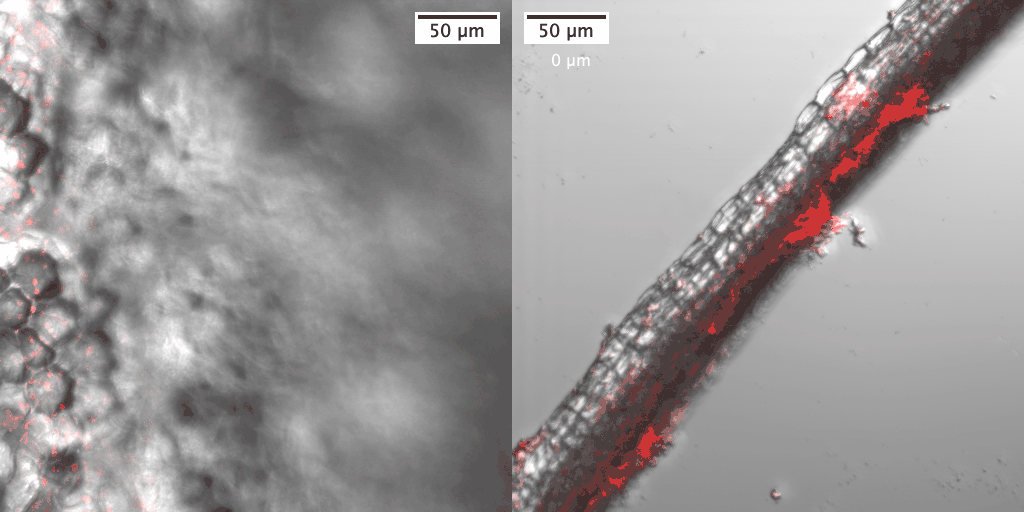December 2019, Leiden
Tracing nanoplastics in and on duckweed
The gifs below show a frond (at the left) and a root (at the right) of a duckweed plant (Spirodela polyrhiza). The red dots in the frond are chloroplasts. The red matter adhered to the root consists of clustered nanoplastic particles.

Over time, the gifs focus on different parts of the frond bottom, and at different optical sections of the root. The depth of the current optical section is indicated by the number below the scale bar in the left top of the gif.
When looking carefully, hexagonal lamella are visible in between the frond cells. Multiple air pockets help fronds float on the surface of the water. The roots of the plant extend into the water.
Why?
Many, if not all, of our freshwater systems are polluted with plastic particles. Over time, these particles fall apart into smaller pieces, eventually reaching nano-scaled sizes. Little is known about the impacts of such nanoplastic particles on freshwater plants.
Duckweed is an aquatic plant that can easily be grown in the lab, owing to its quick development and small size. It is also a common plant in diverse freshwater systems, including ditches, ponds and lakes. Hence, it is a useful test organism to study the impacts of nanoplastic pollution on aquatic plants.
New insight
As you can see, nanoplastic particles attached to the outside of duckweed roots. To a lesser extent, plastic particles adsorbed to the bottom (water-facing side) of fronds (see related content). No plastic particles could be detected inside of the plant. However, it is possible that nanoplastic particles were taken up by plant, but remained hidden by its non-transparant tissue.
The growth of duckweed was not impaired by the exposure to plastic particles. Nevertheless, due to the adsorption of plastic particles to duckweed roots, nanoplastics can concentrate on the plants. Animals that eat duckweed, such as waterfowls, will ingest these concentrated plastic particles. This potential transfer of nanoplastic particles along the food chain warrants further in-depth research.
Method
We exposed duckweed plants to internally died plastic particles that were suspended in the water. The primary particles had a diameter of 50 nm. Using an inverted confocal laser scanning microscope (LSM880, Zeiss), we detected the fluorescent signal of the particle dye (Nile red), as well as the transmitted light. By making optical sections, we tried to distinguish plastic on the outside of plants from plastic inside of its roots and fronds.
Related content
These images were captured as part of a research project that has been published in a special issue of the journal Limnology and Oceanography Letters focused on plastic pollution.